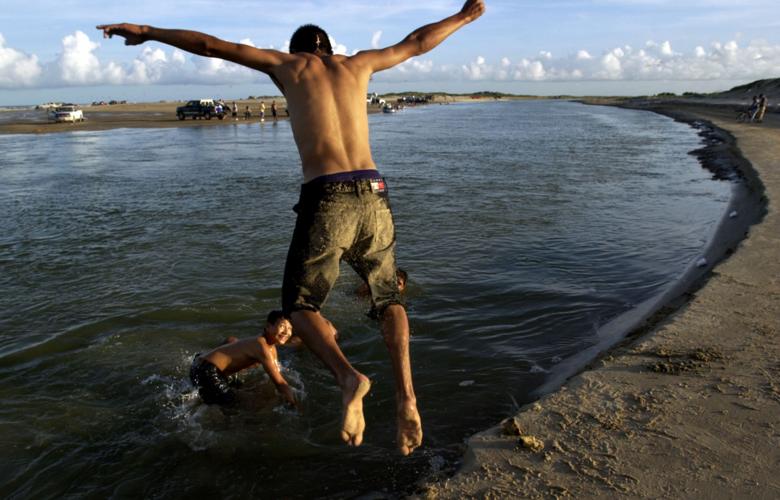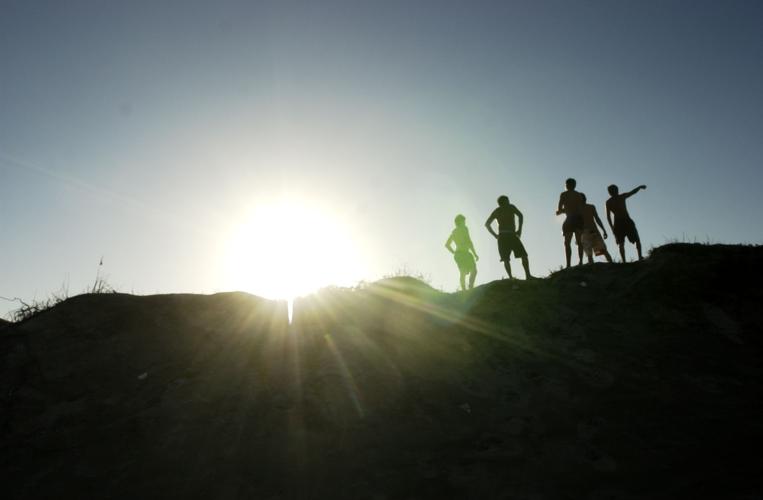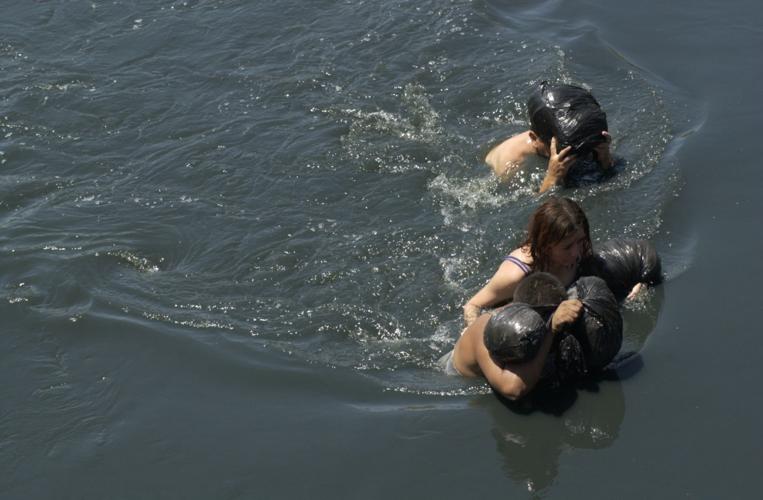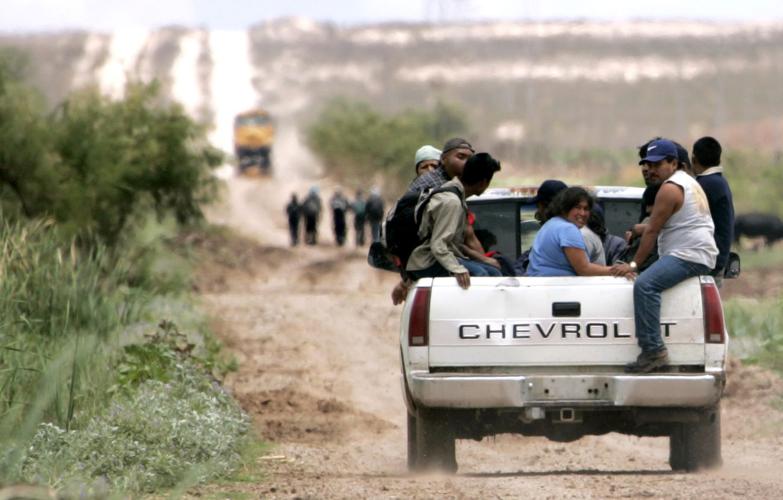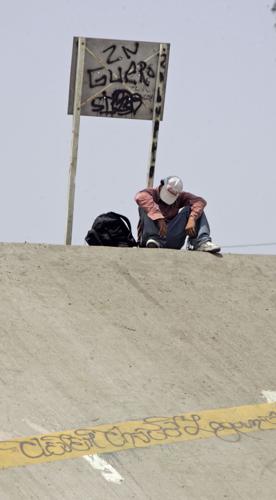The expansive waters of the Gulf of Mexico and the Pacific Ocean flank the nearly 2,000-mile U.S.-Mexican border.
Forty-three legal ports of entry line the southern border, where 5,049 U.S. Customs and Border Protection officers face the grueling task of finding illegal entrants hidden in the sea of 960,000 people who cross daily.
The Canadian border is twice as long, but patrolled by one-tenth as many U.S. Border Patrol agents.
The areas serve as sidelines in the match of vigor and wit that pits illegal entrants against agents. But if the federal government spends the billions of dollars and overcomes the bevy of logistical obstacles to sealing the border, all three would become important corridors, experts say.
As long as U.S. businesses offer better jobs than those available at home, illegal entrants will keep finding new ways into the country, a Star investigation found.

Catching a ride: Tired would-be illegal entrants head east toward Puerto Palomas, Chihuahua. Despite increases in the resources available to fight illegal immigration, people continue to try to cross in the same numbers as a decade ago. "They will find a way, if they need jobs, to get here," U.S. Rep. Jim Kolbe, R-Ariz. said.
"The costs of a 2,000-mile seal of the land border are prohibitively high," says Wayne Cornelius, head of the Center for Comparative Immigration Studies at the University of California at San Diego. "And the punchline is that it wouldn't be effective because it would just divert crossings to the maritime border and the northern border, unless the jobs disappear within the U.S."
Employers in the United States hire illegal workers, making it worthwhile for entrants to pay smugglers. Smugglers then take any measures necessary to get people across.
Traffickers already try to move people and drugs up the coastal waters. They also use fraudulent documents or hide people in gas and engine compartments to sneak through legal ports of entry.
Those tactics are rare because large sections of the border remain passable.
But that could change.
"I don't think there would ever be enough barriers, technology or people that could stop desperate individuals from trying to improve their lot in life," says Deborah Meyers, senior policy analyst for the Migration Policy Institute, a nonpartisan think tank in Washington, D.C.
Illegal entrants already have shifted routes to treacherous areas in response to border crackdowns in popular corridors, and continue to come in the same numbers as a decade ago.
That will carry on no matter what the government does at the border, says outgoing U.S. Rep. Jim Kolbe, R-Ariz., who favors immigration reform that includes a guest-worker program and border enforcement.
"They will find a way, if they need jobs, to get here," he says.

Failed attempt: Illegal entrants try to avoid apprehension by wading near Calexico, Calif., through the New River, which runs with sewage and industrial waste. Border Patrol agents asked them to turn back on foot because of the health risks of contact with the water. The trio did walk back, but through the river.
Crossers try again and again
Even though the increased enforcement efforts of the last decade were meant to keep out illegal entrants, they had the opposite effect in many cases.
Javier Godines first came to the country illegally in 1998. The following year, he brought his wife. Their son was born here in 2004. It was too difficult to cross back and forth, so he settled in Tracy, Calif. This summer, he took the risk and went home for his grandfather's funeral in Jalisco.
On July 26, he sits waiting for the coyote, or smuggler, at the ladrillería, or brickyards, in Sasabe, Sonora. He says he'll keep trying until he makes it.
"I'll return, one, two or however many times I need to," Godines, 30, says in Spanish. He expects it will be more difficult because of the National Guard troops on the border, but, he says, "it doesn't matter. We have to cross."
He did.
It took three days and two nights to walk through the Altar Valley desert in Arizona to get past the increased presence of the Border Patrol, he later says in a call from California.
The trip proved more strenuous than the three times he crossed previously. His group killed 10 rattlesnakes, found a Guatemalan woman who'd been abandoned by another group and heard rumors from other illegal entrants of violence on the trail.
"I suffered more on this trip," Godines says. "It's very difficult because there is more immigration and more patrol, which allows the coyotes to charge you more and walk you more."
Francisco Gutierrez, 28, is one of about 20 would-be illegal entrants who spend two nights in July trying to cross near the Mexican village of Las Chepas, a popular staging area 18 miles west of Puerto Palomas, south of Columbus, N.M.
Each time the group begins to cross, flashlights shine on them from a nearby hill where the National Guard has a camp, Gutierrez says. By sunrise on the third day, they have no food or water and are exhausted.
On a sunny day following a rainstorm, they catch rides back to Puerto Palomas. Some say they'll head home. Others say they'll regroup.
As he climbs into the bed of a red Ford truck, Gutierrez says he'll go home to Chiapas, in southern Mexico.
"There is a lot of patrol. Immigration is bad. ... I'm sad because I couldn't cross," he says in Spanish.
But the reality remains that if they keep trying, illegal entrants eventually will get across, experts say.
"Most people are making it," says Meyers, the migration analyst. "It might take them a few times, they might have been robbed, they might have been assaulted. I'm not saying they make it in good condition, but they are ultimately making it."

CONCRETE BORDER: A yellow line in the Tijuana River basin marks the international border. The river runs north through the border and empties near Imperial Beach in San Diego.
Ports of entry pressured
A sea of cars fills 24 slow-moving lanes that funnel into the U.S. Customs checkpoints at the San Ysidro Port of Entry in San Diego.
The lines stretch south into downtown Tijuana and blend into a colorful blur of commerce. Officers in blue uniforms walk up and down the lines as dogs sniff underneath the vehicles.
A camera scans the license plate of each car as it heads for the booth where a Customs and Border Protection officer conducts an interview.
Many of the travelers are U.S. citizens, legal permanent residents or travelers with tourist, student or business visas.
Others, though, are trying to enter the country with smuggled drugs or people.
Since the Border Patrol launched operations in the mid-1990s to slow traffic in El Paso and San Diego, officials say ports of entry there have seen more attempts to get goods and people through illegally, including the use of fraudulent documents.
Smugglers began hiding people in the same vehicle compartments in which they usually ferried drugs. At a port that inspects 18 million vehicles and 50 million people annually, the haystack is immense. The needle is tiny, elusive and clever.
"As we increase security between the ports of entry and make things harder at the ports of entry, the only thing the bad guys can do is go deeper in their concealments," says James Hynes, director of the San Ysidro Port of Entry.
Officers conduct full name checks on about 25 percent of pedestrian crossers and 10 percent of vehicular crossers, Hynes says. The constant traffic doesn't allow for more.
El Paso faces the same constraint with 38 lanes at four bridge ports of entry, says Roger Maier, spokesman for Customs and Border Protection in El Paso.
"There is a lot of pressure for the officer to keep traffic moving while not letting anything through," he says. "Nobody wants to let the next terrorist into the country."
Ports of entry along the border would experience even more pressure if the government is able to seal the entire border, experts say.
Despite the inherent challenge of finding illegal crossers when they're surrounded by so many legal travelers, it's better than having people cross in the desert, Maier says.
"At least here they are going to face a uniformed officer," he says. "They are going to talk to someone. We are going to have a better idea of who and what's coming into the country."

Looking ahead: On a dare, Mexican industrial designer Rolando Garcia, 27, made a quick illegal crossing to Boca Chica Beach with friends. If he were to stay, he said in Spanish, "I would go to get the knowledge to bring back and create jobs. If I start my own business, that would be a few."
Crossings could move to water
In Texas, Border Patrol agents in boats motor up and down the state's 1,254 miles of the Rio Grande, looking for signs of crossers and trying to discourage would-be illegal entrants with their presence. They work with agents in trucks and on ATVs and horses.
They patrol the river to where it meets the 600,000-square-mile Gulf of Mexico at Boca Chica Beach. That's the beginning of a 250-mile coastal region called "Blue Water."
Agents patrol it with planes, helicopters and boats. The Coast Guard lends eyes and ears as well.
The Customs and Border Protection Office of Air and Marine has 10 boats devoted to the Gulf of Mexico — three stationed at New Orleans and seven in Miami — plus another 53 in Texas, says Juan Muñoz Torres, a Customs and Border Protection spokesman.
Smugglers use the Blue Water area to take narcotics and people up the coast and drop them off at beaches, often in "shark boats," low-profile speedboats that stay close to the coast, says Roy Cervantes, a Border Patrol spokesman in the Rio Grande Valley Sector.
The South Padre Island area — about 15 miles north of Boca Chica — long has been a popular corridor for smugglers, Cervantes says. Sometimes they bury the drugs in the sand for people to pick up later, he says.
They drop off people farther north, near cities such as Kingsville and Corpus Christi, where they can blend in and move on, Cervantes says. Boats usually leave Mexico and go 10 to 30 miles out before heading north, Muñoz Torres says.
The agency doesn't give out apprehension numbers for specific areas such as Blue Water due to security risks, but Cervantes says they're down 14 percent this year across the sector, and smugglers don't use the Blue Water area heavily.
The reward for crossing near cities and roads, even though they're more heavily patrolled, is faster access to the nation's interior, where there are fewer Border Patrol agents.
People smuggling also is cheaper on land. Smugglers take people up the coasts in groups of three to six, so it isn't as cost-efficient as leading 20 through the desert or mountains, says Neville Cramer, who was an Immigration and Naturalization Service special agent for 26 years.
For that reason, the Border Patrol doesn't worry about it much, he says.
So far, traffic hasn't increased in the Gulf or the Pacific, Muñoz Torres says. In fact, the agents assigned to the Office of Air and Marine spend most of their time patrolling the mountains and deserts of Arizona, where traffic is heavier, he says.
The agency knows, though, that if the border seal everyone is talking about actually happens, they'll have to be ready.
"When you put pressure on the border, then people become more willing to take other routes," Muñoz Torres says. "That is when you see people to come to the United States in boats."


